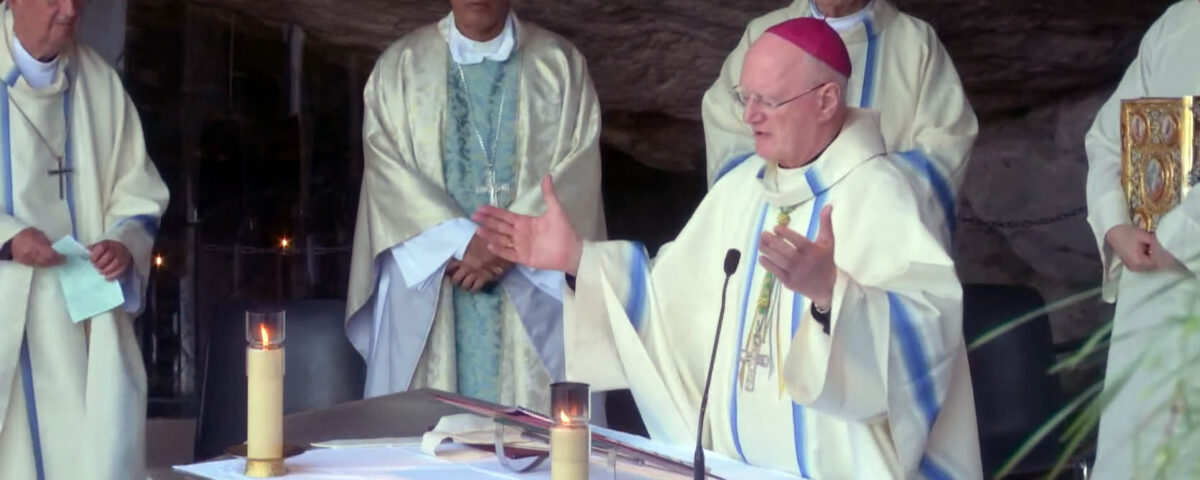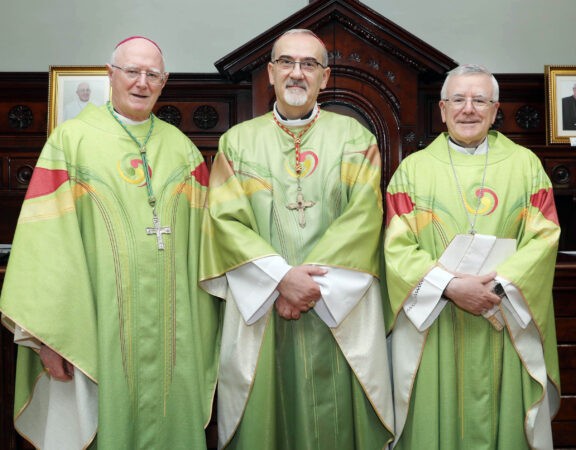Mass for the Opening of Dublin Diocesan Pilgrimage at the Lourdes Grotto
Feast of the Nativity of the Blessed Virgin Mary, September 8, 2023
My friends in Christ, a chairde i gCríost, we gather here this morning, at the shrine of Mary, to begin our pilgrimage. We begin on September 8, the Birthday of our Lady, the beginning of her visible life among us. Of course, there is a deeper beginning, the hidden beginning of her life in God. “I am the Immaculate Conception,” she would say to Bernadette. “Que soy era Immaculada Councepciou” in Bernadette’s local dialect, the words on the statue here above the Grotto.
This morning, then, we celebrate a threefold beginning: the beginning of our pilgrimage, Mary’s birth—the beginning of her visible life, and the Immaculate Conception—the beginning of her life, and ours, in the hiddenness and mystery of God.

Here, in 1858, “God again chose what is foolish in the world”—a girl, on the threshold of womanhood—“to shame the wise.” (see 1Cor 1:27) God chose what is lowly and of no value to the world—the eldest daughter of a poor family, in poor health, with neither knowledge nor power. To her did Mary appear with her call to prayer, penance, and conversion, making present the words of Jesus: “What you have hidden from the wise and understanding, you have revealed to mere children” (Matt 11:25).
But all this did not happen in a vacuum. Very importantly, Mary—the Immaculate Conception —showed Bernadette how to pray. What happened between Mary and Bernadette, and Bernadette’s response to it, draws millions to this holy place, to pray and to serve. “Go and tell the priests that people are to come here in procession, and that a chapel should be built here,” said “the lady,” to Bernadette. The Lord could have built his church in Lourdes without Bernadette, but he sought her involvement. Today the Lord seeks our involvement too: here is a great mystery, and a mystery that touches our very lives. The Lord could have renewed the life of the Church in France through some other great infusion of grace, but God’s way was to call Bernadette, and through her courage, simplicity, and wit, along with that of many other young saints at the time—think of St Thérèse of Lisieux—to inspire the renewal of the Church, in France and beyond. This Bernadette did despite mockery and opposition (see Matt 27:27–31, 41). Calvary is never far away. The appearance of Our Lady at Lourdes was not just for Bernadette—it could be grasped by all; a sign for all pointing to Jesus, Mary’s son, our Lord and Saviour.
Mary’s words to Bernadette, her call of this very young woman from the margins of society, and the margins of France, witnesses to what Jesus wants his followers to do and how to do it. Bringing people to Christ is at the heart of the Church’s work. It is our true centre of gravity. We are a missionary Church. “In the heart of the Church, a missionary fire must always burn” (Pope Benedict XVI, General Audience, February 3, 2010). For Pope Saint Paul VI, “the Church exists to evangelize” (Evangelii Nuntiandi, 16). The Church exists to bring good news. We exist to bring good news. We—the baptized—bring good news, not primarily by what we say, but by what we do, by how we live. Like Christ, we put flesh on good news. That is what the Church is about. Even in our weakness and failure, even in the face of sin and betrayal, that is what we are about. Is that not the meaning of “Go, in peace, glorifying the Lord by your life.” Bernadette’s great call was to fulfill the mission Mary passed on to her, a mission that ultimately came from God, that like the Immaculate Conception itself, had—and has—its beginning in God.
The gospel, our good news, is just not something that we are meant to cling to for our own benefit. Rather, it is like seed that we are meant to give away: “unless a grain of wheat falls into the earth and dies,” says Jesus, “it remains alone” (see John 12:24). Putting flesh on the good news, is something we do together, with others, in parish and community. Bernadette had a religious experience and then, within months, gathered people around her. The same could be said of St Francis of Assisi. Faith doesn’t go it alone. Indeed, if we try go it alone, we will probably end up in very unfruitful or very unhealthy places. Ask anyone who is experienced in the life of faith: “real spiritual experience without guidance runs serious risk.” (André Louf OCSO, Tuning into Grace, DLT, 1992, 80). We need each other at all stages of our life of faith.
Down through the years the many people who have come to Lourdes on pilgrimage have gone forth from here carrying the closeness to God they experienced here back to their homes, and to their places of work. They did not keep their faith a secret; rather, they spread it around, sanctifying the arenas of business, politics, sports—their daily life. In this way they fulfilled the mission of the Church, the mission of all the baptised, which is the transformation of the world, a transformation born of service, and of care for the little ones.
Like Bernadette, when we engage the spiritual dimension of our lives, everything we see and do becomes an opportunity to receive God’s life and love. We are led to living faith. Here, we can see that: the Grotto is not empty. It is not some static image, preserved since 1858. In the prayers of the pilgrims, our prayers, and, particularly, in the Eucharist celebrated here, the transition into reality occurs. It is here at the Grotto, here within us and among us, here in this shrine, in our prayer, and in the welcome and service of the poor and the fragile, that the reality of Lourdes happens. From here we go out; from here we are sent. Know this: renewal in the Church will only come about when all the baptised take ownership of mission that is ours! It is a call to all the baptised, not just to the clergy, not just to religious, but all the baptised.
“Go and tell the priests that people are to come here in procession, and that a chapel should be built here,” said Mary to Bernadette. The work of clergy and the faithful is always in the hands of God. “Go and tell the priests…” were words of a particular place and time. The request of Mary to Bernadette has to be received into our day. Not only have we a call, but we also have a responsibility to understand what the Lord might be asking of us today—both as individuals and as parishes.
Lourdes is a place of many miracles: the hope that flows from the miraculous healings has made this one of the great manifestations of the Kingdom of God in our world. But there are even more powerful miracles, less spectacular, but just as real: there is the grace of acceptance, and there is the miracle of conversion, that is, a change in our lives and an acceptance of the life which God offers us. On this day when we celebrate the birthday of Mary, let us not forget what unfolded in the hiddenness of her life, she who “treasured all these things and pondered them in her heart.” (Luke 2:19). As your bishop, let me assure you that the Holy Spirit has poured the same treasures into our hearts.
As we begin our pilgrimage, let us keep Mary and her faith before us. May her openness and trust inspire us. May her call to Bernadette challenge us. May her prayer be our school of prayer. May this place be a place of blessing for us, and may each one of us be a pilgrim with the other. “Holy Mary, Mother of God … teach us to believe, to hope, to love with you. Show us the way to his Kingdom! Star of the Sea, shine upon us and guide us on our way!” (Pope Benedict XVI, Spe Salvi, 50).
Our Lady of Lourdes, Immaculate Conception: pray for us.
St Bernadette: pray for us.
+Dermot Farrell,
Archbishop of Dublin







